Abstract
The UV component of sunlight is the major carcinogen involved in the etiology of skin cancers. We have studied the rare, hereditary syndrome xeroderma pigmentosum (XP), which is characterized by a very high incidence of cutaneous tumors on exposed skin at an early age, probably due to a deficiency in excision repair of UV-induced lesions. It is interesting to determine the UV mutation spectrum in XP skin tumors in order to correlate the absence of repair of specific DNA lesions and the initiation of skin tumors. The p53 gene is frequently mutated in human cancers and represents a good target for studying mutation spectra since there are > 100 potential sites for phenotypic mutations. Using reverse transcription-PCR and single-strand conformation polymorphism to analyze > 40 XP skin tumors (mainly basal and squamous cell carcinomas), we have found that 40% (17 out of 43) contained at least one point mutation on the p53 gene. All the mutations were located at dipyrimidine sites, essentially at CC sequences, which are hot spots for UV-induced DNA lesions. Sixty-one percent of these mutations were tandem CC-->TT mutations considered to be unique to UV-induced lesions; these mutations are not observed in internal human tumors. All the mutations, except two, must be due to translesion synthesis of unrepaired dipyrimidine lesions left on the nontranscribed strand. These results show the existence of preferential repair of UV lesions [either pyrimidine dimers or pyrimidine-pyrimidone (6-4) photoproducts] on the transcribed strand in human tissues.
Full text
PDF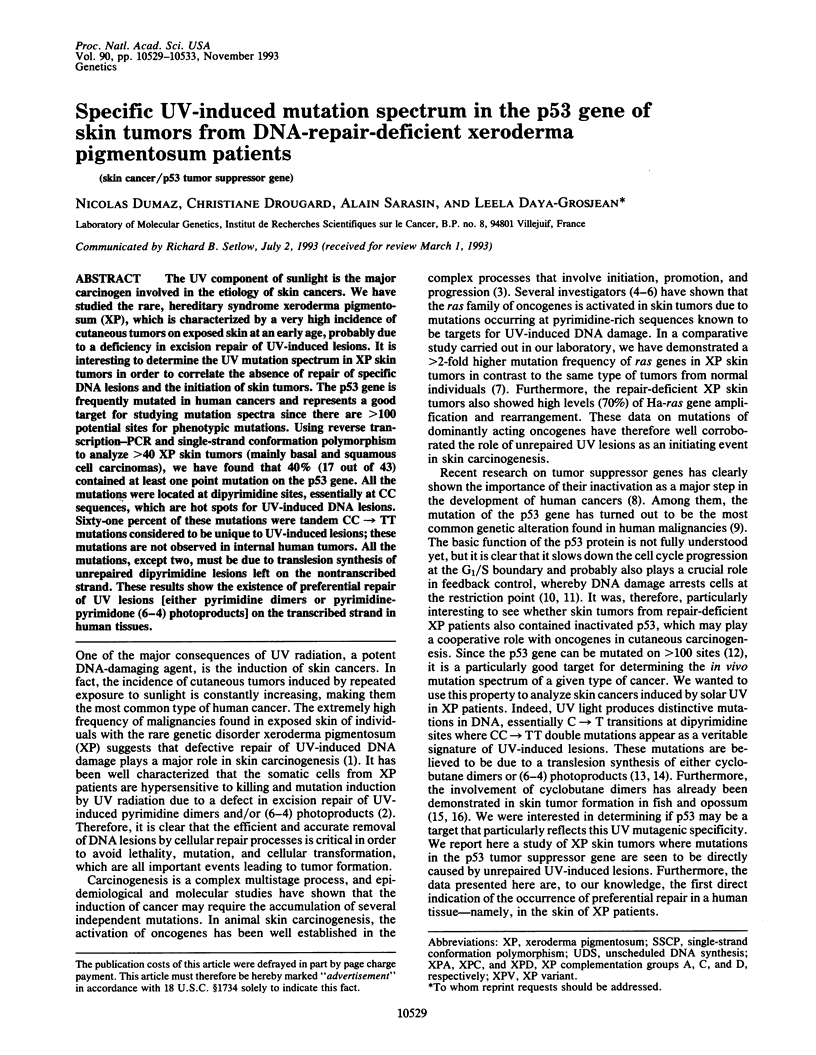
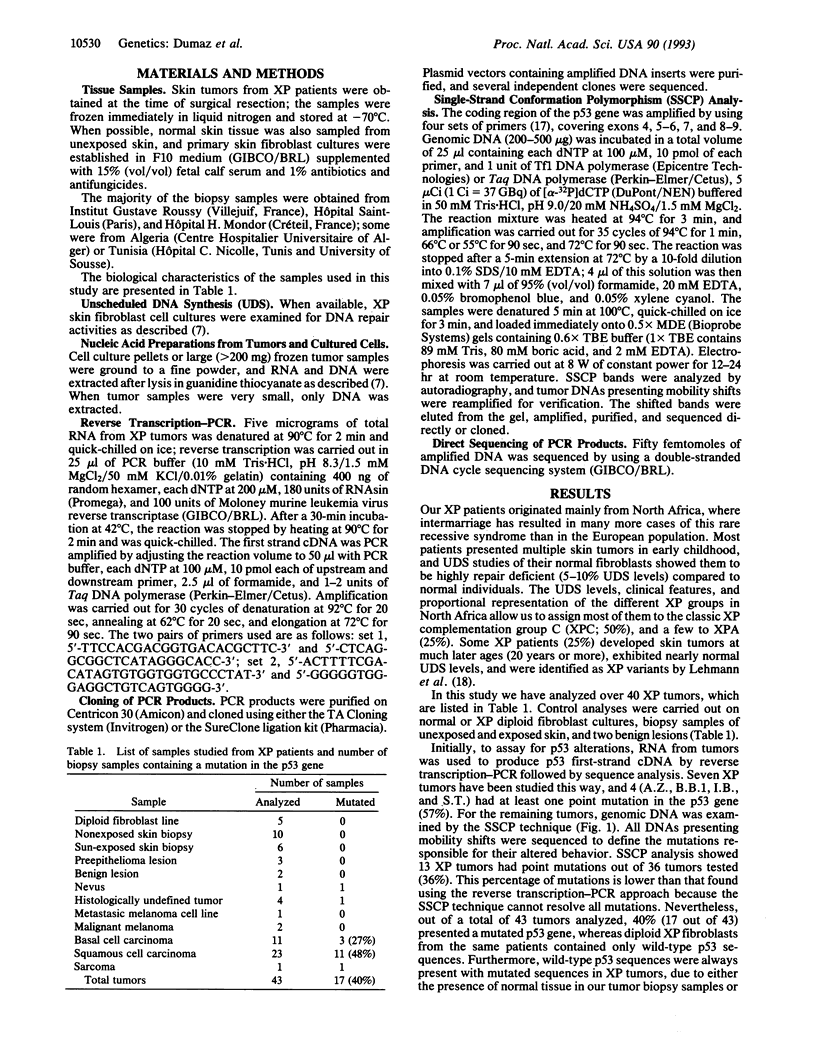
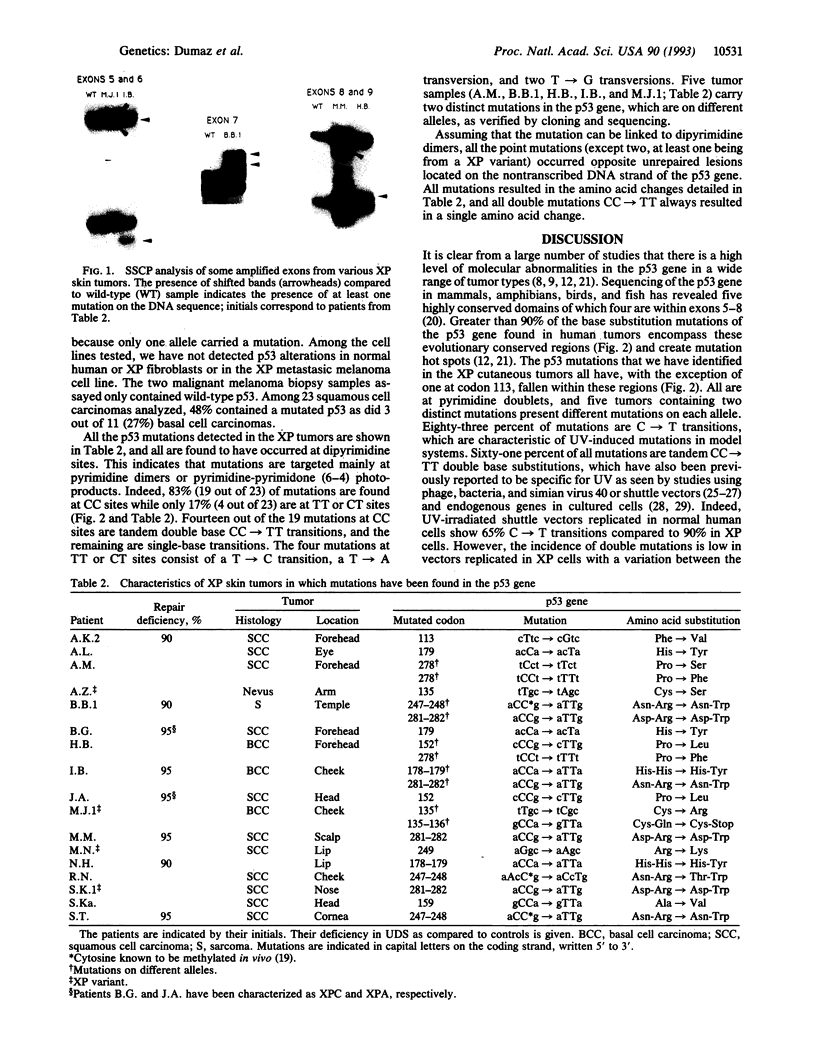
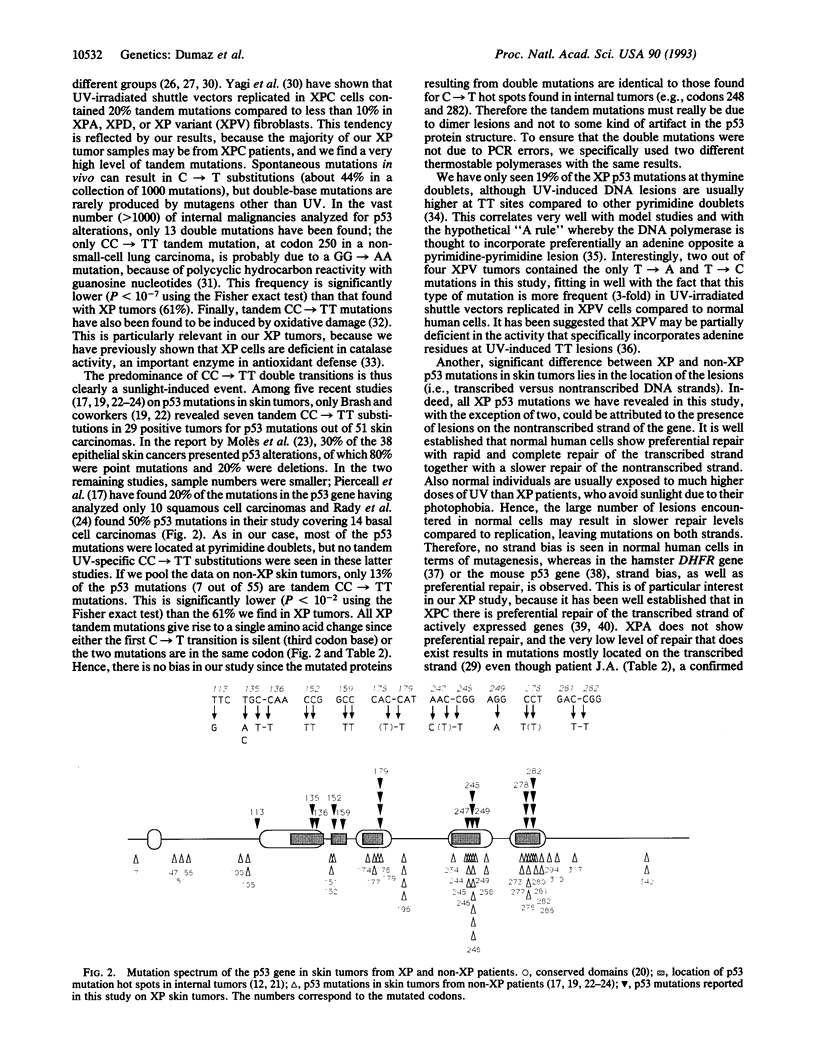
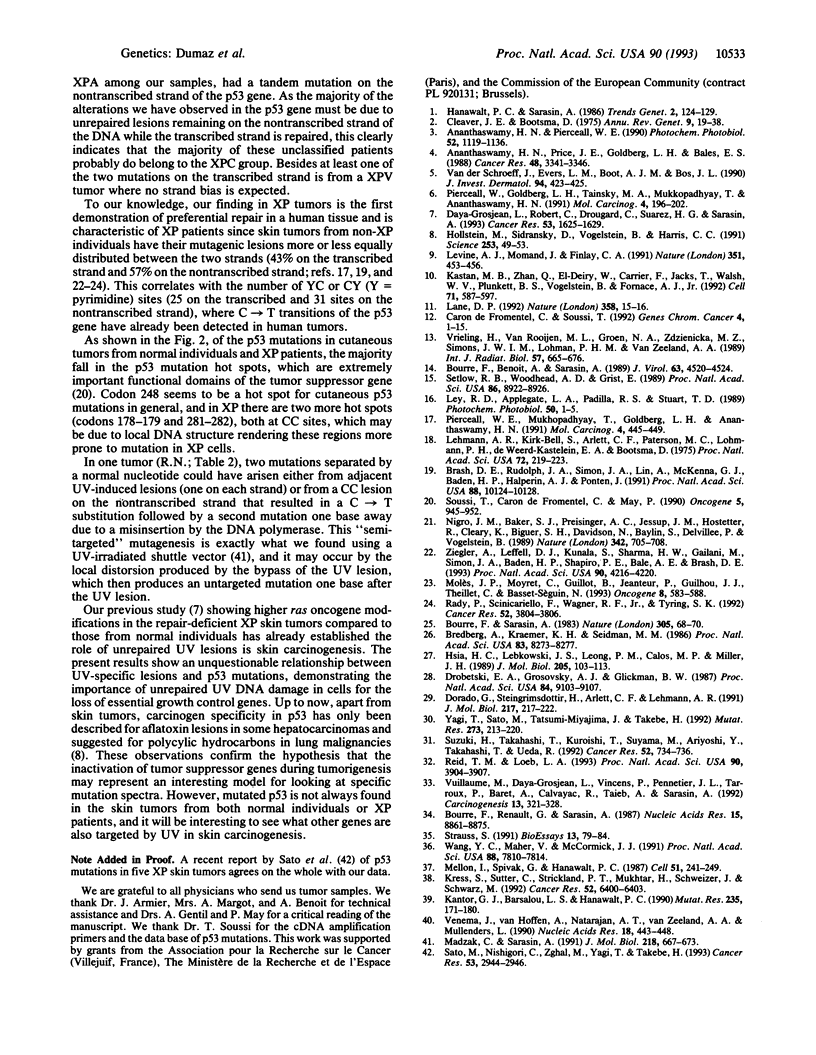
Images in this article
Selected References
These references are in PubMed. This may not be the complete list of references from this article.
- Ananthaswamy H. N., Pierceall W. E. Molecular mechanisms of ultraviolet radiation carcinogenesis. Photochem Photobiol. 1990 Dec;52(6):1119–1136. doi: 10.1111/j.1751-1097.1990.tb08452.x. [DOI] [PubMed] [Google Scholar]
- Ananthaswamy H. N., Price J. E., Goldberg L. H., Bales E. S. Detection and identification of activated oncogenes in human skin cancers occurring on sun-exposed body sites. Cancer Res. 1988 Jun 15;48(12):3341–3346. [PubMed] [Google Scholar]
- Bourre F., Benoit A., Sarasin A. Respective roles of pyrimidine dimer and pyrimidine (6-4) pyrimidone photoproducts in UV mutagenesis of simian virus 40 DNA in mammalian cells. J Virol. 1989 Nov;63(11):4520–4524. doi: 10.1128/jvi.63.11.4520-4524.1989. [DOI] [PMC free article] [PubMed] [Google Scholar]
- Bourre F., Renault G., Sarasin A. Sequence effect on alkali-sensitive sites in UV-irradiated SV40 DNA. Nucleic Acids Res. 1987 Nov 11;15(21):8861–8875. doi: 10.1093/nar/15.21.8861. [DOI] [PMC free article] [PubMed] [Google Scholar]
- Bourre F., Sarasin A. Targeted mutagenesis of SV40 DNA induced by UV light. Nature. 1983 Sep 1;305(5929):68–70. doi: 10.1038/305068a0. [DOI] [PubMed] [Google Scholar]
- Brash D. E., Rudolph J. A., Simon J. A., Lin A., McKenna G. J., Baden H. P., Halperin A. J., Pontén J. A role for sunlight in skin cancer: UV-induced p53 mutations in squamous cell carcinoma. Proc Natl Acad Sci U S A. 1991 Nov 15;88(22):10124–10128. doi: 10.1073/pnas.88.22.10124. [DOI] [PMC free article] [PubMed] [Google Scholar]
- Bredberg A., Kraemer K. H., Seidman M. M. Restricted ultraviolet mutational spectrum in a shuttle vector propagated in xeroderma pigmentosum cells. Proc Natl Acad Sci U S A. 1986 Nov;83(21):8273–8277. doi: 10.1073/pnas.83.21.8273. [DOI] [PMC free article] [PubMed] [Google Scholar]
- Caron de Fromentel C., Soussi T. TP53 tumor suppressor gene: a model for investigating human mutagenesis. Genes Chromosomes Cancer. 1992 Jan;4(1):1–15. doi: 10.1002/gcc.2870040102. [DOI] [PubMed] [Google Scholar]
- Cleaver J. E., Bootsma D. Xeroderma pigmentosum: biochemical and genetic characteristics. Annu Rev Genet. 1975;9:19–38. doi: 10.1146/annurev.ge.09.120175.000315. [DOI] [PubMed] [Google Scholar]
- Daya-Grosjean L., Robert C., Drougard C., Suarez H., Sarasin A. High mutation frequency in ras genes of skin tumors isolated from DNA repair deficient xeroderma pigmentosum patients. Cancer Res. 1993 Apr 1;53(7):1625–1629. [PubMed] [Google Scholar]
- Dorado G., Steingrimsdottir H., Arlett C. F., Lehmann A. R. Molecular analysis of ultraviolet-induced mutations in a xeroderma pigmentosum cell line. J Mol Biol. 1991 Jan 20;217(2):217–222. doi: 10.1016/0022-2836(91)90533-c. [DOI] [PubMed] [Google Scholar]
- Drobetsky E. A., Grosovsky A. J., Glickman B. W. The specificity of UV-induced mutations at an endogenous locus in mammalian cells. Proc Natl Acad Sci U S A. 1987 Dec;84(24):9103–9107. doi: 10.1073/pnas.84.24.9103. [DOI] [PMC free article] [PubMed] [Google Scholar]
- Hollstein M., Sidransky D., Vogelstein B., Harris C. C. p53 mutations in human cancers. Science. 1991 Jul 5;253(5015):49–53. doi: 10.1126/science.1905840. [DOI] [PubMed] [Google Scholar]
- Hsia H. C., Lebkowski J. S., Leong P. M., Calos M. P., Miller J. H. Comparison of ultraviolet irradiation-induced mutagenesis of the lacI gene in Escherichia coli and in human 293 cells. J Mol Biol. 1989 Jan 5;205(1):103–113. doi: 10.1016/0022-2836(89)90368-9. [DOI] [PubMed] [Google Scholar]
- Kantor G. J., Barsalou L. S., Hanawalt P. C. Selective repair of specific chromatin domains in UV-irradiated cells from xeroderma pigmentosum complementation group C. Mutat Res. 1990 May;235(3):171–180. doi: 10.1016/0921-8777(90)90071-c. [DOI] [PubMed] [Google Scholar]
- Kastan M. B., Zhan Q., el-Deiry W. S., Carrier F., Jacks T., Walsh W. V., Plunkett B. S., Vogelstein B., Fornace A. J., Jr A mammalian cell cycle checkpoint pathway utilizing p53 and GADD45 is defective in ataxia-telangiectasia. Cell. 1992 Nov 13;71(4):587–597. doi: 10.1016/0092-8674(92)90593-2. [DOI] [PubMed] [Google Scholar]
- Kress S., Sutter C., Strickland P. T., Mukhtar H., Schweizer J., Schwarz M. Carcinogen-specific mutational pattern in the p53 gene in ultraviolet B radiation-induced squamous cell carcinomas of mouse skin. Cancer Res. 1992 Nov 15;52(22):6400–6403. [PubMed] [Google Scholar]
- Lane D. P. Cancer. p53, guardian of the genome. Nature. 1992 Jul 2;358(6381):15–16. doi: 10.1038/358015a0. [DOI] [PubMed] [Google Scholar]
- Lehmann A. R., Kirk-Bell S., Arlett C. F., Paterson M. C., Lohman P. H., de Weerd-Kastelein E. A., Bootsma D. Xeroderma pigmentosum cells with normal levels of excision repair have a defect in DNA synthesis after UV-irradiation. Proc Natl Acad Sci U S A. 1975 Jan;72(1):219–223. doi: 10.1073/pnas.72.1.219. [DOI] [PMC free article] [PubMed] [Google Scholar]
- Levine A. J., Momand J., Finlay C. A. The p53 tumour suppressor gene. Nature. 1991 Jun 6;351(6326):453–456. doi: 10.1038/351453a0. [DOI] [PubMed] [Google Scholar]
- Ley R. D., Applegate L. A., Padilla R. S., Stuart T. D. Ultraviolet radiation--induced malignant melanoma in Monodelphis domestica. Photochem Photobiol. 1989 Jul;50(1):1–5. doi: 10.1111/j.1751-1097.1989.tb04123.x. [DOI] [PubMed] [Google Scholar]
- Madzak C., Sarasin A. Mutation spectrum following transfection of ultraviolet-irradiated single-stranded or double-stranded shuttle vector DNA into monkey cells. J Mol Biol. 1991 Apr 20;218(4):667–673. doi: 10.1016/0022-2836(91)90252-2. [DOI] [PubMed] [Google Scholar]
- Mellon I., Spivak G., Hanawalt P. C. Selective removal of transcription-blocking DNA damage from the transcribed strand of the mammalian DHFR gene. Cell. 1987 Oct 23;51(2):241–249. doi: 10.1016/0092-8674(87)90151-6. [DOI] [PubMed] [Google Scholar]
- Molès J. P., Moyret C., Guillot B., Jeanteur P., Guilhou J. J., Theillet C., Basset-Sèguin N. p53 gene mutations in human epithelial skin cancers. Oncogene. 1993 Mar;8(3):583–588. [PubMed] [Google Scholar]
- Nigro J. M., Baker S. J., Preisinger A. C., Jessup J. M., Hostetter R., Cleary K., Bigner S. H., Davidson N., Baylin S., Devilee P. Mutations in the p53 gene occur in diverse human tumour types. Nature. 1989 Dec 7;342(6250):705–708. doi: 10.1038/342705a0. [DOI] [PubMed] [Google Scholar]
- Pierceall W. E., Goldberg L. H., Tainsky M. A., Mukhopadhyay T., Ananthaswamy H. N. Ras gene mutation and amplification in human nonmelanoma skin cancers. Mol Carcinog. 1991;4(3):196–202. doi: 10.1002/mc.2940040306. [DOI] [PubMed] [Google Scholar]
- Pierceall W. E., Mukhopadhyay T., Goldberg L. H., Ananthaswamy H. N. Mutations in the p53 tumor suppressor gene in human cutaneous squamous cell carcinomas. Mol Carcinog. 1991;4(6):445–449. doi: 10.1002/mc.2940040606. [DOI] [PubMed] [Google Scholar]
- Rady P., Scinicariello F., Wagner R. F., Jr, Tyring S. K. p53 mutations in basal cell carcinomas. Cancer Res. 1992 Jul 1;52(13):3804–3806. [PubMed] [Google Scholar]
- Reid T. M., Loeb L. A. Tandem double CC-->TT mutations are produced by reactive oxygen species. Proc Natl Acad Sci U S A. 1993 May 1;90(9):3904–3907. doi: 10.1073/pnas.90.9.3904. [DOI] [PMC free article] [PubMed] [Google Scholar]
- Sato M., Nishigori C., Zghal M., Yagi T., Takebe H. Ultraviolet-specific mutations in p53 gene in skin tumors in xeroderma pigmentosum patients. Cancer Res. 1993 Jul 1;53(13):2944–2946. [PubMed] [Google Scholar]
- Setlow R. B., Woodhead A. D., Grist E. Animal model for ultraviolet radiation-induced melanoma: platyfish-swordtail hybrid. Proc Natl Acad Sci U S A. 1989 Nov;86(22):8922–8926. doi: 10.1073/pnas.86.22.8922. [DOI] [PMC free article] [PubMed] [Google Scholar]
- Soussi T., Caron de Fromentel C., May P. Structural aspects of the p53 protein in relation to gene evolution. Oncogene. 1990 Jul;5(7):945–952. [PubMed] [Google Scholar]
- Strauss B. S. The 'A rule' of mutagen specificity: a consequence of DNA polymerase bypass of non-instructional lesions? Bioessays. 1991 Feb;13(2):79–84. doi: 10.1002/bies.950130206. [DOI] [PubMed] [Google Scholar]
- Suzuki H., Takahashi T., Kuroishi T., Suyama M., Ariyoshi Y., Takahashi T., Ueda R. p53 mutations in non-small cell lung cancer in Japan: association between mutations and smoking. Cancer Res. 1992 Feb 1;52(3):734–736. [PubMed] [Google Scholar]
- Venema J., van Hoffen A., Natarajan A. T., van Zeeland A. A., Mullenders L. H. The residual repair capacity of xeroderma pigmentosum complementation group C fibroblasts is highly specific for transcriptionally active DNA. Nucleic Acids Res. 1990 Feb 11;18(3):443–448. doi: 10.1093/nar/18.3.443. [DOI] [PMC free article] [PubMed] [Google Scholar]
- Vuillaume M., Daya-Grosjean L., Vincens P., Pennetier J. L., Tarroux P., Baret A., Calvayrac R., Taieb A., Sarasin A. Striking differences in cellular catalase activity between two DNA repair-deficient diseases: xeroderma pigmentosum and trichothiodystrophy. Carcinogenesis. 1992 Mar;13(3):321–328. doi: 10.1093/carcin/13.3.321. [DOI] [PubMed] [Google Scholar]
- Wang Y. C., Maher V. M., McCormick J. J. Xeroderma pigmentosum variant cells are less likely than normal cells to incorporate dAMP opposite photoproducts during replication of UV-irradiated plasmids. Proc Natl Acad Sci U S A. 1991 Sep 1;88(17):7810–7814. doi: 10.1073/pnas.88.17.7810. [DOI] [PMC free article] [PubMed] [Google Scholar]
- Yagi T., Sato M., Tatsumi-Miyajima J., Takebe H. UV-induced base substitution mutations in a shuttle vector plasmid propagated in group C xeroderma pigmentosum cells. Mutat Res. 1992 Mar;273(2):213–220. doi: 10.1016/0921-8777(92)90082-e. [DOI] [PubMed] [Google Scholar]
- Ziegler A., Leffell D. J., Kunala S., Sharma H. W., Gailani M., Simon J. A., Halperin A. J., Baden H. P., Shapiro P. E., Bale A. E. Mutation hotspots due to sunlight in the p53 gene of nonmelanoma skin cancers. Proc Natl Acad Sci U S A. 1993 May 1;90(9):4216–4220. doi: 10.1073/pnas.90.9.4216. [DOI] [PMC free article] [PubMed] [Google Scholar]
- van der Schroeff J. G., Evers L. M., Boot A. J., Bos J. L. Ras oncogene mutations in basal cell carcinomas and squamous cell carcinomas of human skin. J Invest Dermatol. 1990 Apr;94(4):423–425. doi: 10.1111/1523-1747.ep12874504. [DOI] [PubMed] [Google Scholar]



